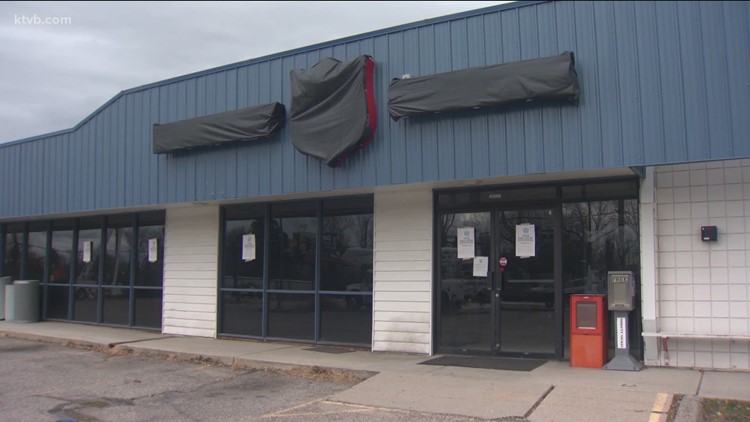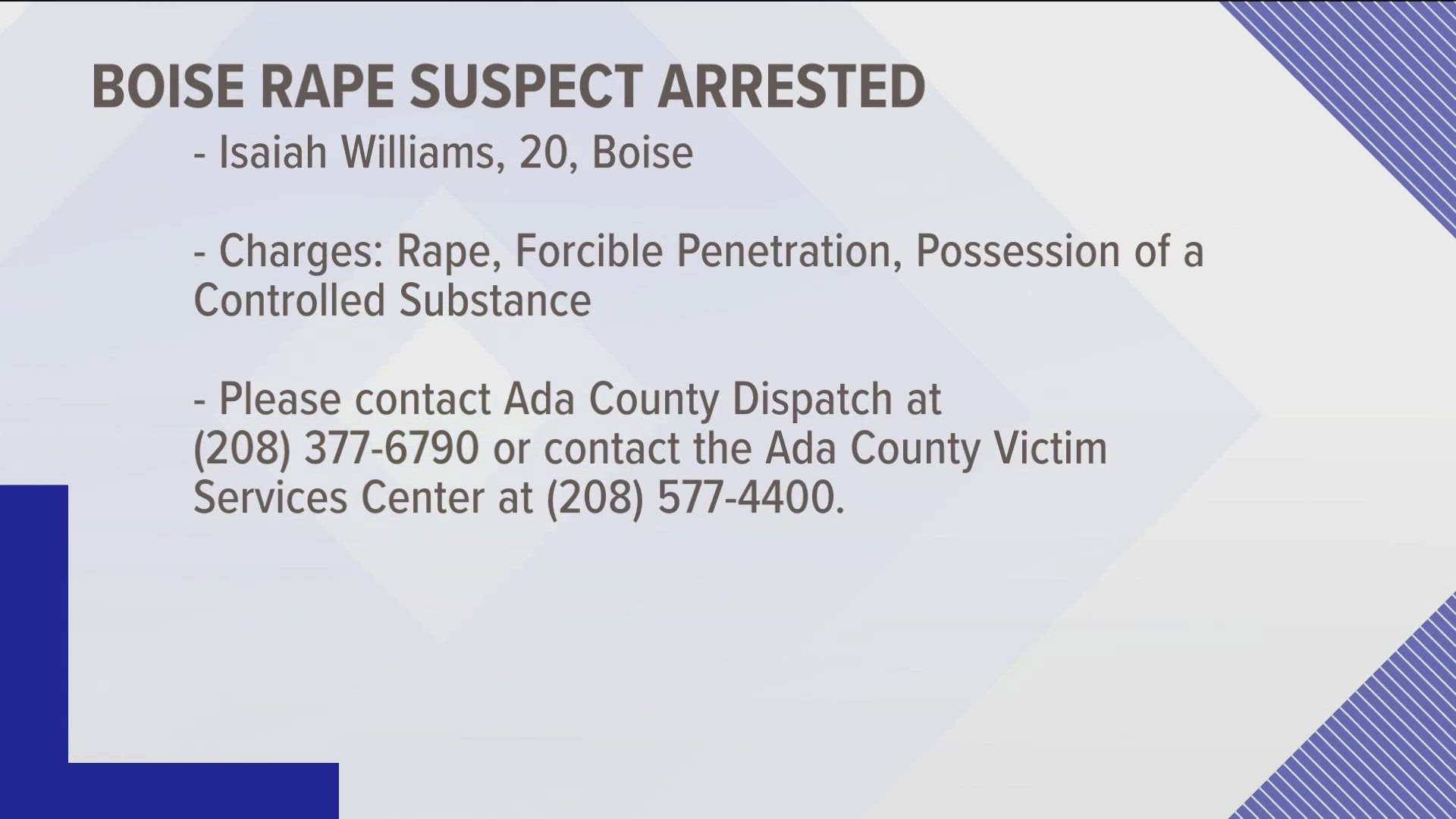BOISE, Idaho — Editor's Note: This article was originally published by The Idaho Press.
As the debate swirls around where to house Boise residents who are experiencing homelessness, shelter guests themselves are caught in the middle.
“We need the space,” an Interfaith Sanctuary guest said during an April meeting of the shelter’s Project Well Being program, which provides a space for group therapy, artwork, and gatherings. He's written a letter contesting the representations he’s seen of homeless people in the local media and online, but he hasn't sought to get it published because he feels he's too upset.
“There are so many guests who have written things. They want to get their voices out," Interfaith Sanctuary Executive Director Jodi Peterson-Stigers said. "They want to be known as their name and their story as opposed to the homeless, the ‘them,’ the ‘they,’ the alcoholics, the drug addicts, the predators. They’re so hurt. And, a little nervous.”
Interfaith Sanctuary plans to move to a new State Street campus so it can expand its space and offer more transitional housing and programming all on one site to help people on their path toward securing a home. Last month, the shelter purchased a former Salvation Army facility in northwest Boise and will next go through the approval process with the city of Boise.
The effort has caused concern for neighboring residents who say the new project, called Interfaith Sanctuary Community Housing with roughly 200 beds, is not a good fit for the area. Some residents have held protests, walking back and forth across State Street with signs in hand, attempting to demonstrate how a crowd of homeless people would slow down traffic.
“I think the implication is that homeless people don’t know how to cross streets, whereas, they have to navigate the streets way more often than the average citizen," Peterson-Stigers said. "Their survival skills are tremendous because of the fact they’ve been forced into a world where there is no home for them, so they’re constantly walking and crossing streets and navigating a town on streets."
One man held a large cardboard hypodermic needle cutout. Others held signs stating, “No Mega Shelter,” “City Problem, City Solution,” and “No Shelter in Any Neighborhood.”
Leaders of the Veterans Park Neighborhood Association, who said the protests organizers were not representing the association, have argued that the shelter would be a move toward “concentrated poverty,” or an area where a high proportion of residents live below the poverty line. Valor Pointe, a 27-unit apartment building for veterans experiencing homelessness, opened along State Street in the neighborhood last summer, and some of the neighborhood's existing residents are facing income and housing insecurity.
Association treasurer Peter Barnes said the U.S. Department of Housing and Urban Development "has clearly identified a direct correlation between concentrated poverty and negative outcomes for individuals within poverty — less children finishing high school, more domestic violence, worsening health effects and greater numbers of folks suffering with mental illness and substance use.”
Katy Decker, vice president of the neighborhood association, said there are at least three houses on her street where the families are on the edge of eviction.
Peterson-Stigers noted that some of the local residents may one day benefit from the services Interfaith provides. She has pushed back against narratives that the new shelter would drastically increase the neighborhood's poverty rate or lead to large groups of people loitering.
She pointed out that guests may choose to spend their time on the shelter's campus, where they'll have access to a garden, a park and a dining room, "and if they do choose to go outside and they choose to cross the street, and they choose to go to a public park — that is their right," Peterson-Stigers said. "That’s not loitering. That’s being part of the neighborhood.”
A group opposed to the new State Street site sought to raise money online for a different shelter space. The GoFundMe page, created by Boise Neighbors for Better Housing, was taken down after Interfaith Sanctuary's lawyer sent a cease-and-desist letter, claiming the fundraiser attempted to fraudulently represent the shelter and raise money on its behalf.
An email sent with a link to the fundraiser argued that the Red Lion Hotel in downtown Boise, the former Cottonwood Suites on Main Street or City of Boise facilities on 17th Street and Shoreline Drive would better suit the needs of the homeless.
“We’re concerned with the folks living literally on the other side of the fence here," resident Bobbie Aitchison said during a protest in April. "Imagine being the parent of a child jumping on the trampoline and you have 200 bodies of any sort enjoying the sunshine of the other side of the fence. What might that sound like?”
In response to neighbors' concerns, Interfaith's leaders, who held a virtual meeting with residents in February, delayed the application for a permit so they could give a tour of the proposed site first. They also lowered the number of proposed beds from 278 to roughly 200, with fewer overnight emergency beds and more individual rooms for guests searching for affordable housing who meet employment, sobriety and behavior requirements, BoiseDev reported.
The Veterans Park Neighborhood Association plans to turn out in large numbers to appeal the permit if approved, according to an April 28 neighborhood meeting. Association leadership has instructed residents to refer to Boise's homeless population using “respectful” language and to refer to things like crime statistics to make their arguments.
Asked whether the homeless shelters or any shelter in particular in the Cooper Court area of downtown, where Interfaith is currently located, leads to a higher crime rate, a Boise Police Department spokesperson said, "Some of the biggest drivers for calls for service in the area are just because people are living their private lives in public and it results in requests for welfare checks not criminal issues."
Decker argued that Interfaith and other shelters could be working with currently available beds more effectively. But according to Peterson-Stigers, this is a misunderstanding of the needs of the shelter's clients, as well as its mission.
Interfaith’s proposed move represents both an expansion of its physical space and a continuing shift to a community housing model that provides emergency shelter and longer-term supportive services and private rooms.
“We’re not an emergency shelter anymore. We can’t just be that overnight stay, because people are staying in their homelessness longer — and not because of lack of trying, but because of lack of access," Peterson-Stigers said.
The site would serve as a day center and have space for families and people who are medically vulnerable — something the shelter currently provides off-site in partnership with a hotel. The new campus would have more room for support services such as case management, group programs, computer access and job fairs. The location is near grocery stores, clinics and a major bus line.
“I think that we understand the downtown homeless community better than most because we know who stays with us, we know who needs services because they’re unsheltered," Peterson-Stigers said.
GROWING HOUSING CRISIS
Interfaith Sanctuary is one of a handful of organizations in Boise that provides emergency shelter. Its proposed expansion comes as the Treasure Valley grows rapidly, with the population of Ada and Canyon counties growing by more than 150,000 people, or 27%, in the last decade.
The number of people experiencing homelessness has also grown. In 2020, the federally mandated Point-In-Time count found 1,668 individuals in Ada County living unsheltered or in a homeless shelter, up by more than 400 people from 2018. The counts are taken in a one-night snapshot and do not include people living with friends or relatives, in a hotel/motel, or in a treatment facility or jail.
“Without shelter, there are people out on the street, and we can’t catch up with housing for the count that’s in need," Peterson-Stigers said.
As housing costs rise, more residents may be forced out. The median price of a single-family home in Ada County was $392,230 in 2020, an increase of more than $163,000 over five years, according to the Intermountain Multiple Listing Service.
Renters in Ada County saw the average rent for a one-bedroom apartment go from $631 in 2015 to $988 in the first quarter of 2021, along with fewer available units, reports from the Southwest Idaho chapter of the National Association of Residential Property Managers show.
“Once your rent has been raised and you’re forced out, getting back in is impossible," Peterson-Stigers said. "There’s no place that’s as cheap as where you were."
Eviction rates dropped 30% during the pandemic, BoiseDev reported in March, which experts have attributed to court closures, rental assistance and a federal eviction moratorium. But the eviction moratorium is set to end June 30, and those who serve the Treasure Valley’s homeless residents expect to see more people facing housing insecurity as eviction proceedings begin again.
A lack of rent control measures in Idaho and shortage of housing that is actually affordable to someone coming out of homelessness, rather than someone moving to Idaho from out of state, is a problem in the Treasure Valley, Peterson-Stigers said. Homelessness “is absolutely going to grow," she said. “The housing market is out of control.”
SHELTER MODEL
Interfaith's vision for the State Street shelter was partly inspired by research suggesting that emergency shelters need to redefine their model. In 2018, the National Alliance to End Homelessness recommended to the city of Austin, Texas, a coordinated model that provides both emergency shelter as well as low-barrier housing for people so they could first have a secure place to stay before being expected to overcome other challenges, such as recovering from addiction or finding a job.
“That’s exactly what the Salvation Army shelter represents, that step up,” Peterson-Stigers said. "… What we could do is create an element of housing for this building. Instead of looking at as many beds as possible, we’re going to build rooms.”
“We have a number of people in our shelter who go to work, they’re sustainable, and they’re on a waiting list to get housing. The only reason why they’re still homeless is because we can’t get them into housing. It’s not there. We want to give them a house of their own inside of our building until we can find that housing they’ve earned.”
BED SPACE
Interfaith Sanctuary is one of a handful of shelters in downtown Boise, which during normal operations can house 164 each night, with 20 of those spots being floor mats. COVID-19 has reduced that number to 140, with 87 at a hotel.
The proposed shelter includes 94 beds for families with children, 22 beds in a medical dorm for residents in need of health or hospice care, 20 single and double rooms, 24 dormitory-style beds, and 40 "incentive beds" for residents who are ready for a more permanent space and are participating in substance abuse or mental health programming.



